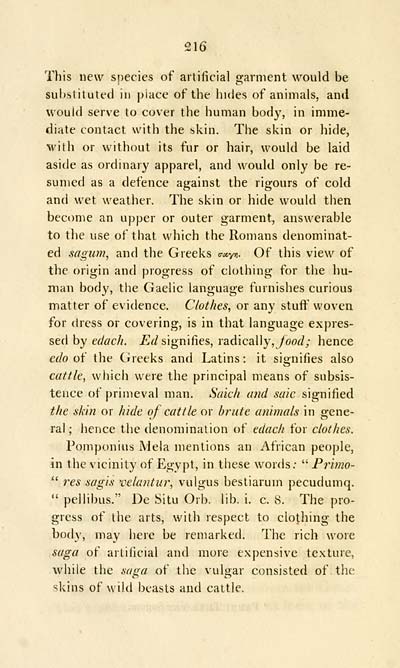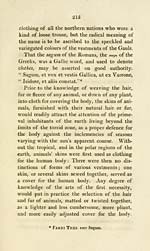Download files
Complete book:
Individual page:
Thumbnail gallery: Grid view | List view

216
This new species of artificial garment would be
sul)stituted in piace of the hides of animals, and
would serve to cover the human body, in imme-
diate contact with the skin. The skin or hide,
with or without its fur or hair, would be laid
aside as ordinary apparel, and would only be re-
sumed as a defence against the rigours of cold
and wet weather. The skin or hide would then
become an upper or outer garment, answerable
to the use of that which the Romans denominat-
ed sagum, and the Greeks o-^y)). Of this view of
the origin and progress of clothing for the hu-
man body, tiie Gaelic language furnishes curious
matter of evidence. Clothes, or any stuff woven
for dress or covering, is in that language expres-
sed by e^^^c/z. £^/ signifies, radically, /oo^; hence
edo oi' the Cireeks and Latins: it signifies also
cattle, which were the principal means of subsis-
tence of primeval man. Saich and sale signified
the skin or hide of cattle or brute animals in gene-
ral ; hence the denomination of edach for clothes.
Pomponius Mela mentions an African people,
in the vicinity of P2gypt, in these words; " Primo-
" res sagis velantur, vulgus bestiaruin pecudumq.
" pellibus." De Situ Orb. lib. i. c. 8. The pro-
gress of the arts, with respect to clothing the
body, may here be remarked. The rich wore
saga of artificial and more expensive texture,
while the saga of the vulgar consisted of the
skins of wild beasts and cattle.
This new species of artificial garment would be
sul)stituted in piace of the hides of animals, and
would serve to cover the human body, in imme-
diate contact with the skin. The skin or hide,
with or without its fur or hair, would be laid
aside as ordinary apparel, and would only be re-
sumed as a defence against the rigours of cold
and wet weather. The skin or hide would then
become an upper or outer garment, answerable
to the use of that which the Romans denominat-
ed sagum, and the Greeks o-^y)). Of this view of
the origin and progress of clothing for the hu-
man body, tiie Gaelic language furnishes curious
matter of evidence. Clothes, or any stuff woven
for dress or covering, is in that language expres-
sed by e^^^c/z. £^/ signifies, radically, /oo^; hence
edo oi' the Cireeks and Latins: it signifies also
cattle, which were the principal means of subsis-
tence of primeval man. Saich and sale signified
the skin or hide of cattle or brute animals in gene-
ral ; hence the denomination of edach for clothes.
Pomponius Mela mentions an African people,
in the vicinity of P2gypt, in these words; " Primo-
" res sagis velantur, vulgus bestiaruin pecudumq.
" pellibus." De Situ Orb. lib. i. c. 8. The pro-
gress of the arts, with respect to clothing the
body, may here be remarked. The rich wore
saga of artificial and more expensive texture,
while the saga of the vulgar consisted of the
skins of wild beasts and cattle.
Set display mode to: Large image | Transcription
Images and transcriptions on this page, including medium image downloads, may be used under the Creative Commons Attribution 4.0 International Licence unless otherwise stated. ![]()
| Early Gaelic Book Collections > Ossian Collection > Thoughts on the origin and descent of the Gael > (228) |
|---|
| Permanent URL | https://digital.nls.uk/82237180 |
|---|
| Description | Selected books from the Ossian Collection of 327 volumes, originally assembled by J. Norman Methven of Perth. Different editions and translations of James MacPherson's epic poem 'Ossian', some with a map of the 'Kingdom of Connor'. Also secondary material relating to Ossianic poetry and the Ossian controversy. |
|---|
| Description | Selected items from five 'Special and Named Printed Collections'. Includes books in Gaelic and other Celtic languages, works about the Gaels, their languages, literature, culture and history. |
|---|

